By Jeffrey A. Rendall, Photos by Jeffrey A. Rendall
OCEAN VIEW, DE – It’s not easy to turn phragmites into gold, but it’s arguable that’s what they’ve done at Bear Trap Dunes Golf Club near the eastern shore in Delaware.
For those unfamiliar with phragmites (as I was), Wikipedia defines it for us: “the common reed, is a large perennial grass found in wetlands throughout temperate and tropical regions of the world.”
A very few may find beauty in phragmites, but for most people it’s an ugly, invasive eyesore that takes over dormant land and is extremely difficult to eradicate (the states of Maryland and Delaware are trying to do just that). That’s where we come to the story of Bear Trap Dunes, the 27-hole golf facility near Bethany Beach that opened in 1998 (the third nine opened in 2001) and has served as a shining ‘reclamation’ project ever since.
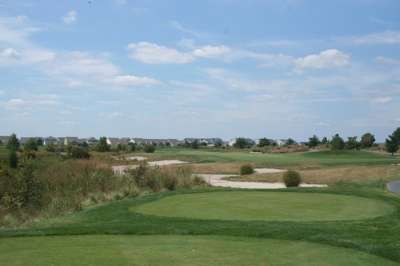 |
| Rick Jacobson cleverly disguised the playability of the par four 5th hole (Grizzly), making the 'safe' area appear much smaller than it really is. |
Bear Trap Dunes’ golf holes were designed by former Nicklaus associate Rick Jacobson, who’s been out on his own for over fifteen years now and has built a nice reputation in the Mid-Atlantic for scripting playable, fun and aesthetically pleasing golf courses.
Jacobson takes the story from here. “We’d worked with the people who were looking to build the project before (the late Danny Stoval and the Freeman group), so we were excited about getting an opportunity to develop a facility near Bethany Beach in Delaware. We found a tract of land and then started the process of figuring out how to turn it into a golf course.”
It sounds like the end of the story, but it was really just the beginning.
“Bear Trap Dunes was an interesting project,” Jacobson remembered. “As an architect, sometimes you walk out on a site and it feels like you’ve got to preserve everything you can on this quality piece of property because it’s so beautiful – you can literally see seventeen or eighteen golf holes in its natural, undisturbed state.”
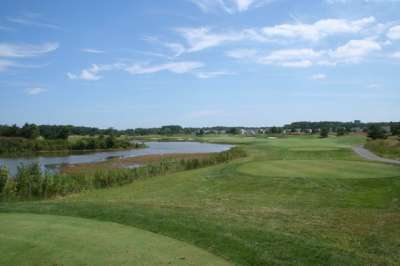 |
| Risk-reward all the way at the par four 6th hole (Grizzly). At 387-yards, cut off as much of the dogleg as you dare. |
“But Bear Trap Dunes wasn’t like that,” Jacobson added.
Far from the pristine piece of ground that golf course designers are hesitant to alter, Bear Trap Dunes was a former farm that had been lying dormant for at least a year, was practically flat – and even worse, was inundated with phragmites. Jacobson described them as tall grassy pests with wispy seed heads that had already taken over the drainage ditches.
Jacobson continues, “When you get a site like that, you look around at the other golf courses in the entire market and try to determine what you can do with that particular piece of property to make it compete – what will give it a marketing edge against the competitors in that area and to create an interesting golf experience that will draw golfers.”
After a bit of investigation, Jacobson and the owners discovered that the site was far from hopeless and even offered up something that would give it its distinctive ‘marketing edge’ that they were looking for – an underlying layer of white sand.
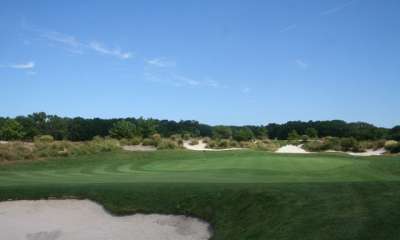 |
| Greenside at the Grizzly nine's par three 4th hole, you get a feel for the sand dune theme at Bear Trap Dunes |
“As soon as we saw the sand,” Jacobson observed, “we knew we had a piece of property that we could transform into dunes that you would find along the ocean – we used the white sand to bring the dunes back inland and take advantage of a chance to create something unique.”
And that’s how the ‘dunes’ concept evolved. You might think the ‘Bear Trap’ part was in reference to Jacobson’s close association with the Golden Bear, but the name is actually a takeoff on the property’s former name – Bear Trap Farm.
As soon as the sand was discovered, Jacobson weaved golf holes around dunes, simultaneously dealing with the phragmites as they went along. But that wasn’t the end of the environmental story.
“The ditches that were dug for drainage purposes within the agricultural fields ended up being delineated as wetlands,” Jacobson explained. “So a man-made ditch that was overgrown with phragmites, a species they’re trying to eradicate – was now declared a protected wetlands.”
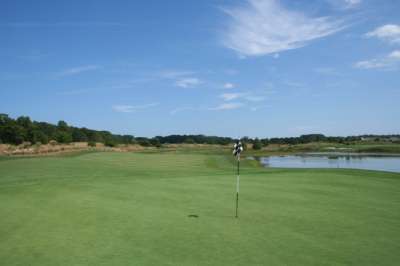 |
| Looking back from the green of the par three 8th hole (Grizzly), take a moment to relax and soak in the beauty of Bear Trap Dunes. |
Delineating a piece of ground as a wetland doesn’t mean it can’t be touched – but if you fill it, that creates an ‘impact’ which must be mitigated by creating other wetlands areas. Jacobson said it was an odd situation, taking something that was totally dysfunctional as an existing wetland and creating a whole water system and wetlands throughout the golf course to make up for it.
Golfers benefit from the end result, however, as Bear Trap’s ‘new’ environment has permanently changed for the better.
“We were particularly proud of the way that we were able to transform the property from what it used to look like compared to the way it is now. When you look at all those wetlands we created at Bear Trap Dunes, and there’re always a variety of birds and frogs and turtles and we’ve seen otters and other wildlife – none of which was on the property before the golf course was there. It’s a co-existence between nature and the game of golf,” Jacobson said proudly.
And the phragmites are gone – but they occasionally come back. Jacobson said they were buried under six feet of material, but that doesn’t necessarily get rid of them. Talk about a resilient pest.
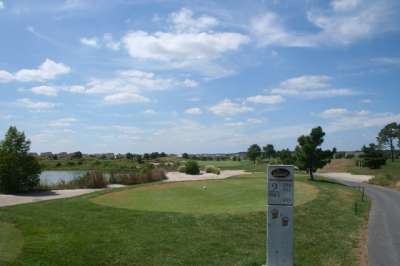 |
| Heading for home on the par five 9th hole (Grizzly), a good chance for a birdie if you play it long and straight. |
In addition to being a natural wonder, Bear Trap Dunes is a very playable golf course with wide hitting areas, big greens and fair bunkering. Jacobson says playability was always the ultimate goal on the site, which is a contrast to many of the golf facilities being built in recent times. “I go out there and sometimes just hang around the pro shop and I hear the comments – the golfers are having fun out there, and they score well. I think the game of golf needs more courses like Bear Trap Dunes to make it fun instead of so punishing.”
The sand dunes make it distinctive, too – but don’t call it ‘links-style.’
If a golf course doesn’t have many trees, the tendency these days is to label it a links course, but Jacobson says that was not the intention at Bear Trap Dunes. “All the trees on the site wrap around the periphery of the property, so only a few holes actually have them – so the dunes give the course a little bit of a links feel. But the bunkering was not done in a true links style. The mounding would have had to have been a lot more severe and exaggerated instead of rounded and flowing like what you see at Bear Trap.” “So there’s a different way we would’ve done it if we’d wanted more of a true links concept,” Jacobson concluded.
The fact that Bear Trap Dunes is playable doesn’t make it a pushover. There’s enough trouble in the form of lakes, dunes, wetlands and waste bunkers to mandate a playing strategy for each hole. The par fives are short enough to allow for risk-reward strategies, and the bunkering is prevalent and well placed.
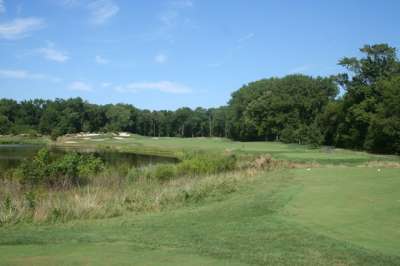 |
| Here's a unique look at Bear Trap Dunes - the tree-lined par four 5th hole on the Kodiak nine. |
In other words, you’re still going to earn your good scores.
But as Jacobson alluded to above, first and foremost, Bear Trap Dunes is good fun. There aren’t any golf ball swallowing carries, and the greens all allow for a run-up shot. The slopes are gentle and the rough is thick but cut short.
The playing conditions were also excellent, and we played at the end of August after a very dry summer.
And because the facility’s 27-holes (three nines are named Grizzly, Kodiak and Black Bear) are neatly contained on a core piece of property, the tees and greens are reasonably close together – which makes for a very walk-able golf course, and also greatly aids in pace-of-play. Where the five-hour round is becoming all too common at many clubs, at Bear Trap Dunes the scorecard indicates that you should be able to finish in a little over four hours.
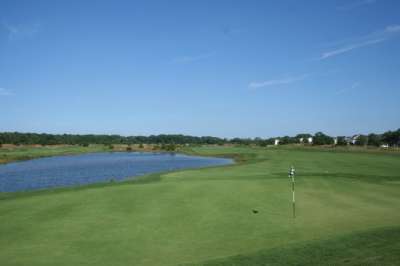 |
| At 550-yards, the par five 7th hole is the Kodiak nine's longest hole - but there's also plenty of room to play all three shots. |
We played on an afternoon that wasn’t crowded, and it took about three and a half hours, and we didn’t hurry – playing the Grizzly and Kodiak nines.
Favorite holes included the 425-yard, par four 5th hole (Grizzly), the nine’s #1 handicap hole. From the tee, the landing area looks relatively small, and there’s trouble all down the left side. If you bail too far to the right, you’ll leave a lengthy second shot on this challenging hole.
The par five ninth hole winds its way back towards the clubhouse, and offers a chance for long hitters to knock it on in two (534-yards) – but you’ll still have to thread the needle to reach the well bunkered green.
The Kodiak nine provides a unique look at Bear Trap Dunes – a hole where you’ll have to avoid the trees (at least somewhat) on the 382-yard, par four fifth. Trees protect the right side while dunes and bunkers frame the left – a medium length hole that demands accuracy.
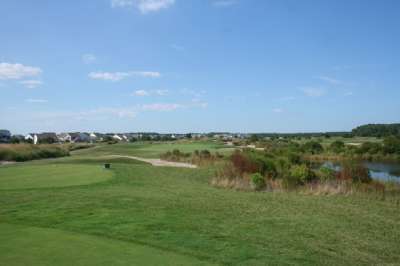 |
| Testimony to the playability of Bear Trap Dunes - almost all the trouble is to the sides of the golf holes, such as here at the par three 8th hole (Kodiak). |
The round concludes (on Kodiak) with the 427-yard, par four ninth hole, which conveniently leaves you right at the clubhouse – and there’ll likely be extra time to enjoy some liquid refreshment before you leave.
Like most newer vintage Golf Clubs, Bear Trap Dunes is part of a residential development – but as with the trees on the property, the houses are only on the periphery of the land. It’s not often that the golf is given its own space, and that quality is reflected in the golf holes.
Bear Trap Dunes definitely deserves a place on your itinerary the next time you head to Delaware’s eastern shore, where you can marvel at the good things that building a golf course can do for the environment.
Where we stayed
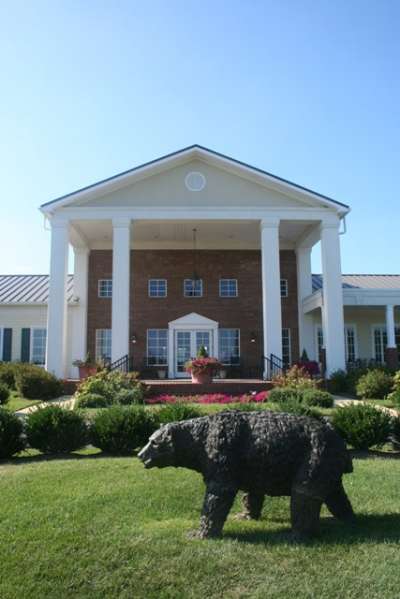 |
| The bear statue near the clubhouse is one more nice feature at Bear Trap Dunes. |
While visiting Bear Trap Dunes and Bayside resort, we stayed at the Holiday Inn Express – Bethany Beach Hotel, which was conveniently located near the golf courses and the beach, as well as local restaurants and attractions.
Bethany Beach Hotel
710 South Coastal Highway
Bethany Beach, DE 19930
Phone: (302) 541-9200
Fax: (302) 541-4057 Email: info@holiday-bethany.com
Details:
7 Clubhouse Drive
Ocean View, DE 19970
Phone: 302-537-5600
Toll-free: 1-877-BEARTRAP
FAX: 302-537-7947
Website: www.beartrapdunes.com
Course Designer: Rick Jacobson
General Manager: Jack Stone
Tees/Yardage/Rating/Slope
Grizzly/Kodiak Combination:
Championship 6834 72.1/126
Back 6426 69.9/122
Club 5817 67.2/117
Forward 5208 69.8/120
Black Bear/Grizzly Combination:
Championship 6901 72.7/130
Back 6429 70.4/126
Club 5821 67.7/121
Forward 5094 69.4/121
Kodiak/Black Bear Combination:
Championship 6853 72.4/130
Back 6377 70.1/126
Club 5748 67.3/120
Forward 5074 69.1/118
Rates:
2009 Golf Fees
Spring (March 1 – April 16): Weekday $50; Weekend $70
(April 17 – June 26): Weekday $80-$85; Weekend $95-$100
Summer (June 27 – August 31): Morning $99-$125;
Mid-day Special (after 11 am) $79-$99
Fall (September 1 – October 16): Weekday $80; Weekend $95-$100
(October 17 – November 2): Weekday $60; Weekend $80
Consult the Website for Winter rates.
| Related Links | Comments on this article? | |
|
Maryland National Golf Club Hollow Creek Golf Club Rocky Gap Resort PB Dye Golf Club in Ijamsville Whiskey Creek Golf Club |
E-mail Jeff Rendall, Editor: jrendall@golftheunitedstates.com |











